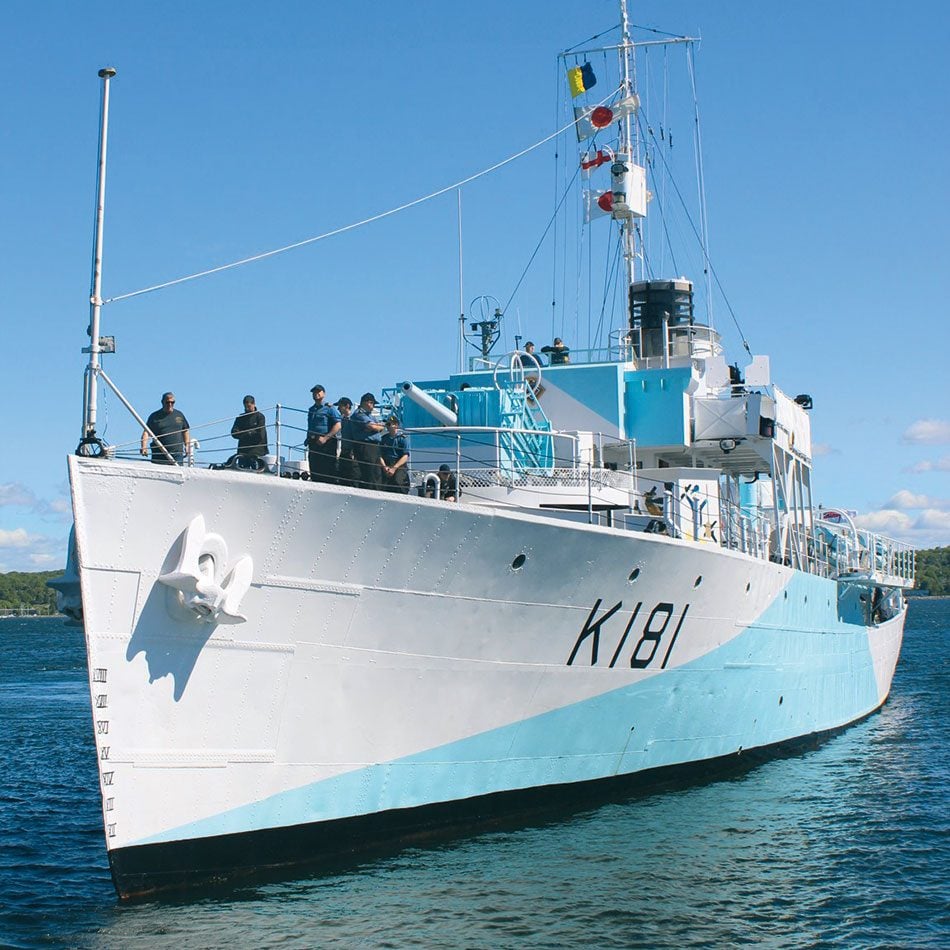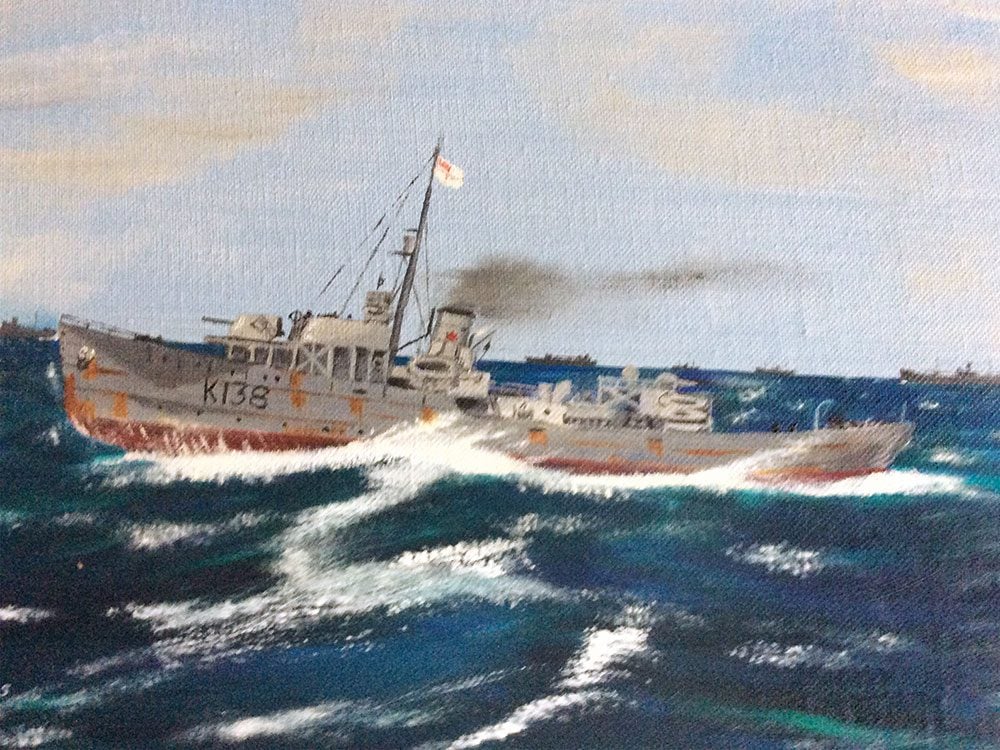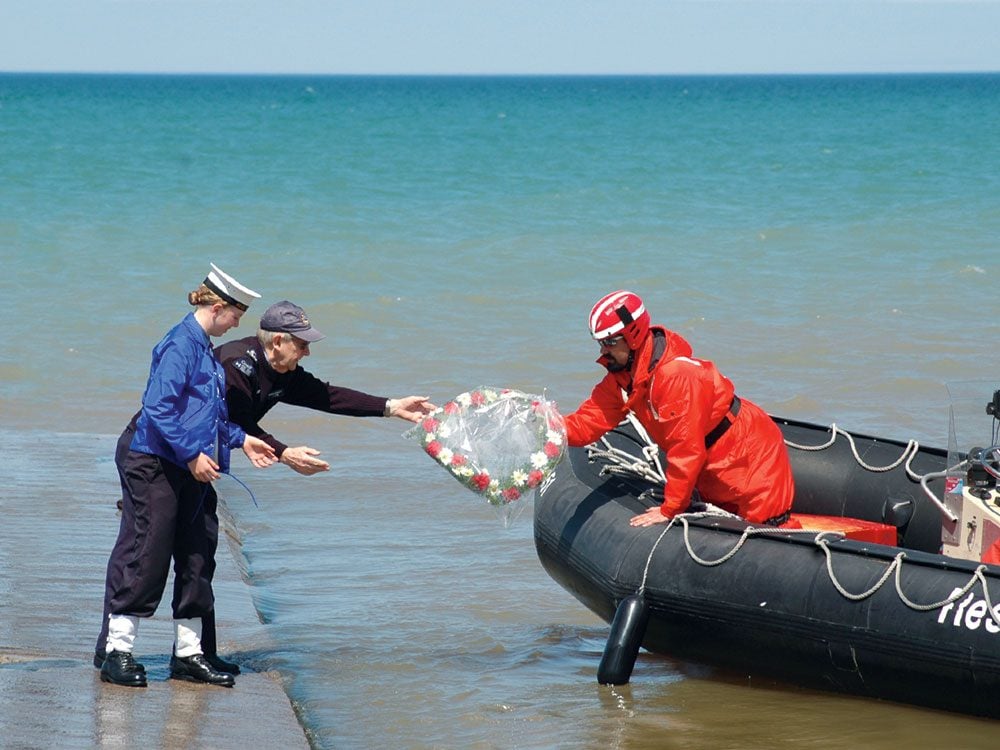
The Story of HMCS Sackville: One of Canada’s Forgotten Heroines
The mystique around ships includes the fact that all who sail aboard them refer to the vessels as a “she.”
Legends abound as to how this came about. The one I prefer is that a ship cradles within itself life, her crew, and therefore is womb-like. Although created from inanimate materials, to sailors, ships become living entities.
This is a story about a type of naval vessel which was critical in winning the Battle of the Atlantic that began in 1939 and lasted until 1945—the longest battle of WWII. The ship was the corvette, a small but ultimately deadly escort vessel for vital convoys across the North Atlantic.
In 1939, the pre-war Canadian Navy comprised a group of aging destroyers manned by peacetime professionals, plus a wide variety of harbour craft, training vessels and such. This was the Royal Canadian Navy, and it was full of tradition. All across Canadian Naval establishments each morning, the White Ensign was raised, parade grounds filled and resounded to petty officers’ bawled orders, these being met by stamping boots and sailors marching in unison. On a daily basis, naval officers, clerks and secretaries entered their respective offices ashore, each dealing with a myriad of protocols, orders and general documentation. A navy ready for war at sea it was not. This was about to change—drastically!
In 1939 the British Admiralty recognized the desperate need for escort vessels to protect vital shipping in the North Atlantic during the now inevitable war with Nazi Germany. Their navy at the time was considered inadequate to protect convoys of merchant ships supplying Britain with vital supplies from the submarines of the powerful German Kriegsmarine U-boat fleet. The Admiralty chose a ship designed initially as a whaling trawler.
The next challenge was to decide who would build them in sufficient time and quantity. The British Admiralty turned to Canada as a possible source.
The program called for Canada to build 64 corvettes plus a number of other types of ships, such as minesweepers, which were to be manned within two years. This program would be modified and expanded again and again as Canada’s fledgling shipbuilding yards became more proficient.
The initial corvette design was that of a simple, sturdy vessel with sufficient range to provide escort to trans-Atlantic convoys: 205 feet in length, 33-foot beams, powered with a simple steam engine, and armed with powerful depth charges, each containing 300 pounds of explosives capable of sinking or damaging a submarine. Their initial surface armament comprised a four-inch naval gun mounted on the foredeck and light machine guns located on a platform aft of the funnel. Variations on these depended on availability rather than suitability. The design was to be kept as simple as possible so that smaller shipyards could build them without need to expand their existing capabilities. By February 1940, the building program was underway in Canada.
Read the fascinating story of how these Canadians helped make D-Day a success.

Visiting HMCS Sackville at the Maritime Museum in Halifax
HMCS Sackville is Canada’s last and only surviving corvette, one of those little ships that helped win the Battle of the Atlantic, and she is also one of the ships which helped reform Canada’s Navy.
HMCS Sackville began her life in the Saint John Shipyard and Dry Dock Co. Ltd in New Brunswick in 1940, and was commissioned into the Canadian Navy in 1941. She saw active service throughout the war, escorting convoys both to and from UK ports.
She now lies alongside the Maritime Museum in Halifax. Throughout the summer months, her decks are alive with tourists and visitors. Young adults, children and teens walk around her looking at the outdated, old-fashioned equipment and layout. Some, very few now, walk her decks with memories.
She, too, has her memories, not all of them pleasant, but Sackville was part of a fleet of 123 similar vessels which won the Battle of the Atlantic. Day after day, they stood guard over convoys of vulnerable merchant vessels carrying precious cargoes of fuel, food, munitions and supplies to war-torn Britain.
Their crews, mostly reservists or young volunteers, many with no naval or even boating experience, who had been hurriedly trained and dispatched to these little ships, struggled to cope with the new routines. They learned naval terminology, how to carry out orders and face long hours on watch. They learned to deal with oil-soaked and severely injured survivors of torpedoed merchant ships while living in cramped and frequently wet accommodations below decks. They ate, slept and relaxed packed into long, narrow mess rooms with low headroom and no chance of privacy. Officers too, had minimal and cramped accommodations.
Their captains, mostly Merchant Navy reservists, were faced with taking their raw crews and knocking them into efficient fighting units in mere weeks. If a young captain had a chief engineer in his crew who had worked as a steam locomotive engineer, he was fortunate. Some vessels had difficulty leaving harbour because of the inexperience of their officers and men.
Nevertheless, this new Canadian Navy quickly became experts at their jobs and these little ships became the nemesis of U-boat commanders who roamed the dark seas seeking out convoys of unarmed merchant ships carrying vital supplies to Britain.
The plucky corvettes and their crews hunted down any submarines by making sonar contact, then raining down depth charges in patterns designed to crush the submarine with their explosives. When this happened, there were rarely any enemy survivors. Sometimes, the submarine would be caught on the surface, where the guns of the corvette would attempt to hit and damage the U-boat sufficiently to prevent it from submerging.
Life aboard a corvette at sea was far from pleasant, even in calm seas, a rarity in the North Atlantic. They rolled and pitched incessantly when at sea. In early versions of the corvette, food had to be carried to the messes across open decks and frequently arrived cold, if it arrived at all!
If you get the opportunity to visit Halifax, go down to the Maritime Museum where HMCS Sackville is berthed during the summer and open to visitors. This small, now “old lady” lies proudly restored to her former glory for your viewing.
Here are 10 more essential east coast experiences worth adding to your bucket list.

The Battle of the Atlantic
The Battle of the Atlantic, which was waged from 1939 to 1945, was different from any other battle in that most of the participants were civilians. Merchant seamen were not part of any armed forces. The crews of the merchant vessels carrying the vital supplies to beleaguered Britain could do little but watch from their unarmed vessels while hard-pressed naval escort ships tried valiantly to protect them. To a great extent, the Battle of the Atlantic was “Canada’s war” as the vast majority of the escort warships were Canadian. By the end of the Second World War, the Royal Canadian Navy had grown to become the third largest navy in the world. Twenty-four Canadian naval ships and seven motor torpedo boats were sunk during the battle.
Every year, on the first Sunday in May, ceremonies are held across the country to commemorate the Battle of the Atlantic. If you can, please attend your local ceremony and remember those who sailed and served in these valiant little ships.
While heading up our local Canadian Coast Guard Auxiliary Marine Rescue Unit “GAMRU” (Grimsby Auxiliary Marine Rescue Unit) some years ago, I initiated a ceremony here in Grimsby, Ontario, to commemorate the historic battle.
Next, check out these powerful true stories of Canadian veterans.